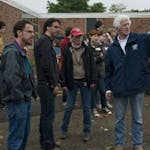The Proposal
⋆⋆⋆⋆ out of four stars
Not rated
Theater: Edina.
There's a bizarre triangle at the center of this odd and fascinating documentary in which filmmaker Jill Magid, a conceptual artist, is the storyteller and part of the story.
One side of the triangle is Luis Barragán, who died in 1988. He is widely considered one of Mexico's greatest architects. His work is known for its serene beauty and emotional use of color, and his professional archive — or, rather, access to it — is the issue around which the film revolves.
The other two sides are Magid, a passionate fan of his work, and Federica Zanco, the director of the Barragan Foundation, which is in Switzerland (where Zanco lives) and, for whatever reason, does not use the accent in Barragán's name.
Since 1996, when Zanco's husband, Rolf Fehlbaum, the former head of the Swiss furniture company Vitra, bought Barragán's archive for a reported $2.5 million as a gift for his wife — a fascinating story in itself — Zanco has controlled access to it as she purportedly prepares to publish a catalogue raisonné of his work. Decades later, she is still working on the book, and the archive is still, for the most part, off limits to everyone else.
Magid's film, which is a piece of performance art and a documentation of that performance, tracks her correspondence with Zanco in an effort to persuade her to grant Magid access to the archive or, more critically, to return it to Mexico, where many in that country feel it rightfully belongs.
Zanco repeatedly — but politely — puts Magid off, citing the scholar's need to focus on her research. Their communications culminate in a face-to-face meeting, during which Magid makes the unusual proposition that is referenced in the film's title. She has exhumed some of the late architect's cremated remains (with his family's permission) and fashioned them into a synthetic diamond that she presents to Zanco: Accept this diamond, a little piece of Barragán, in exchange for returning the archive to Mexico.
Ghoulish? Perhaps, but the film moves beyond that.
Magid raises issues of national heritage and the ethics — perhaps even the morality — of sealing up intellectual property in a tomblike vault. Who should have access to an artist's legacy?
That's only one of many good questions that are raised in this mesmerizing exercise in artistic interrogation.
Michael O'Sullivan,
Washington Post
Woodstock: Three Days That Defined a Generation
⋆⋆ out of four stars
Not rated
Theater: Lagoon.
If you're looking for music in this telling of the oft-told story of the famed 1969 rock festival, you're going to be disappointed. This conventional PBS-style piece intends to deliver the story behind the event without much more than the slightest nod to the music.
Using vintage footage, the film uses voice-overs drawn from an oral history of participants, attendees and organizers done many years ago. Much of the footage comes from the original 1970 film "Woodstock" by director Michael Wadleigh, footage that has been sliced and diced from one end to the other in various versions over the past five decades.
Director Barak Goodman never lets the music breathe. The movie doesn't even get to the opening moments of the show until it's halfway through.
And even then, it just dribbles out little pieces of the songs without ever once allowing more than a glimpse of the massive glory, the sheer power and raw beauty of the historic performances that entranced the audience of half a million on that hillside in upstate New York.
Goodman's decision to have the music take a back seat is something like reviewing the process of publishing a book without discussing what the book is about. If the filmmaker had trusted the music and not suffocated it with voice-overs and quick cuts, he would have been able to pump life into what otherwise turned out to be a relatively pedestrian, tame tale with nothing new imparted.
PBS and "American Experience," the producers of this documentary, usually don't release their work theatrically. True to form, they have made a movie that's a perfect fit for home viewing, its inevitable destination, but hardly the scale of theater screens.
Joel Selvin, San Francisco Chronicle





